
Figure 1. The Future Classics
Top Row - Left to Right (weight, filter size, image circle)
90mm f8 Nikon Nikkor SW (355g, 67mm, 235mm)
110mm f5.6 Schneider Super Symmar XL (430g, 67mm, 288mm)
120mm f5.6 Schneider Super Symmar HM (390g, 67mm, 211mm)
Middle Row - Left to Right (weight, filter size, image
circle)
135mm f3.5 Carl Zeiss Planar T* (565g, 67mm, 180mm)
135mm f5.6 Rodenstock APO Sironar-S (215g, 49mm, 208mm)
150mm f5.6 Rodenstock APO Sironar-S (230g, 49mm, 231mm)
150mm f5.6 Schneider Super Symmar HM (740g, 77mm, 254mm)
Bottom Row - Left to Right (weight, filter size, image
circle)
240mm f9 Fujinon A (245g, 52mm, 336mm)
300mm f9 Nikon Nikkor M (270g, 52mm, 325mm)
360mm f8 Nikon Nikkor T-ED (805g, 67mm, 210mm)
(shown with 500mm rear element - 185g)
360mm f10 Fujinon A (475g, 58mm, 504mm)
450mm f12.5 Fujinon C (285g, 52mm, 486mm)
Update (6/08/00): Well, I've finally gotten around to
updating my Future Classics section. In addition to finally adding the lenses I
mentioned elsewhere on this site (240mm Fujinon A, 450mm Fujinon C and 110mm Super Symmar
XL), I've added a few more including one you might find quite surprising (135mm Planar
T*). 4x5 is still my bread and butter format, but I've been playing around with 5x7
lately. I'm not sure if 5x7 will ever be sufficiently popular to drive up demand for
any lens specifically for that format, but what the heck (I bet they said the same thing
about long Dagors and the banquet formats 75 years ago). Many of the lenses I
consider Future Classics for 4x5 use also can serve double duty on the 5x7 format (90mm f8
Nikkor SW, 110mm f5.6 Super Symmar XL, 150mm f5.6 APO Sironar-S - barely, 240mm f9 Fujinon
A, 300mm Nikkor-M, 360mm Fujinon A, 450mm f12.5 Fujinon C) and some even on 8x10 (240 A,
300 M, 360 A, 450 C). The only lens I added specifically for 5x7 was the 150mm f5.6
Supper Symmar HM. I've also added information on lens weights (actual measured
weight of my samples without lens caps), filter size and manufacturers' specified image
circle. To make this page more visually appealing and give you an idea what these
things actually look like, I've also added photos of all the lenses mentioned. I've
left my original comments intact (in black text). New entries, and annotations to the old, are in teal colored text.
It should be noted that all four current major large format lens
manufacturers are well represented on this list, along with Zeiss, who no longer makes
large format lenses (but I hear they are well respected for their medium format and 35mm
lenses). Nikon is represented at both the wide end (90mm f8 Nikkor SW) and the long
end (300mm f9 Nikkor M and 360/500mm f8/11 Nikkor T-ED). Schneider is represented by
their Super Symmar lines, both XL (110mm f5.6 Super Symmar XL) and HM (120mm f5.6 Super
Symmar HM for 4x5 and 150mm f5.6 Super Symmar HM for 5x7). This is one case where
the use of the word "Super" is more than just marketing hype. These lenses
truly are "Super" in terms of innovative design, large coverage and outstanding
sharpness. Rodenstock is represented by their excellent APO Sironar-S line (135mm
f5.6 APO Sironar-S or 150mm APO Sironar-S - take your pick). Fuji large format
lenses were not readily available when I wrote my original Future Classics post.
Thanks primarily to Badger Graphic Sales, the Fujinon large format lenses are now readily available at very
reasonable prices. Due to their combination of very small size, huge coverage and
excellent performance, Fuji lenses from the A series (240mm f9 Fujinon A and 360mm f10
Fujinon A) and C series (450mm f12.5 Fujinon C) are included in my updated Future Classics
list. The legendary Zeiss Planar (135mm f3.5 Planar T*) rounds out the list. I
have chosen these lenses based on unique combinations of attributes where they offer clear
advantages over all other lenses of the same focal lengths. Comments regarding
specific lens lines (Super Symmar XL and HM, APO Sironar-S, etc.) can generally be
extended to other members of those lens lines. This is especially true when
considering longer lenses for larger formats (i.e. 180mm and 210mm APO Sironar-S for 5x7,
240mm APO Sironar-S, 150mm Super Symmar XL and 210mm Super Symmar HM for 8x10, etc.).
(04/09/99) A couple years ago, I started a thread titled "Future Classics" in
the usenet newsgroup rec.photo.equipment.large-format. Here's a copy of that
post. I will eventually make a few additional comments on new products that weren't
available at the time of that post, but most of the information in the original post is
still valid, so here it is in its entirety (if you are interested in what others had to
say, you can look this thread up on deja.com assuming the archive is available when you read this).
Hi All,
This thread was prompted by some thoughts I had earlier today and the comments of Bernice
Loui in the highly favorable review she posted of her new 110mm Schneider Super Symmar XL.
Basically, what I was wondering is: which of the large format lenses in current, or
recent, production are destined to become highly sought after classics decades after they
are no longer being made. We all know about the Dagors. Which are still highly prized
(especially those with serial numbers higher than 770xxx, Gold Dot Dagors and Wide Angle
Dagors). The Red Dot Artars are also very highly regarded and always in demand in the
longer focal lengths. Kodak is well represented with the Commercial and Wide Field Ektars.
And the Voigtlander APO Lanthar commands ridiculously high prices (this one, frankly
baffles me). There are more, but these are representative of the lenses that are currently
highly prized classics.
What makes a classic? Well, in many cases these older lenses offer something not found in
the current product lines from the few remaining large format lens manufacturers. Some
offer large coverage in a small package (Dagors and Wide Field Ektars). Others offer
outstanding performance at a much lower cost than their modern counterparts (Commercial
Ektars). And some come in focal lengths not available in the current crop of large format
optics (long focal length Artars). The real key, is that they fill a need, and are highly
suited to specific applications (ultra large and banquet formats where large coverage
and/or long focal lengths are needed, or field photography where small size and weight are
important factors).
With that in mind, what current lenses do you think are destined to be future classics? To
get the ball rolling, I'll toss out a few from my current stable of lenses. I currently
shoot landscapes in 4x5 and 6x17 formats using color transparency film. Obviously, someone
who shoots 12x20 black and white will have a different opinion, so it would help if you
would state your format and media of choice along with a brief summary of the reasoning
behind your choices. Perhaps if we can all agree on a few of these future classics we can
hoard a few away to finance the college educations of our grandchildren or great
grandchildren.
My nominees (Actual Weight, Filter Size, Image Circle):
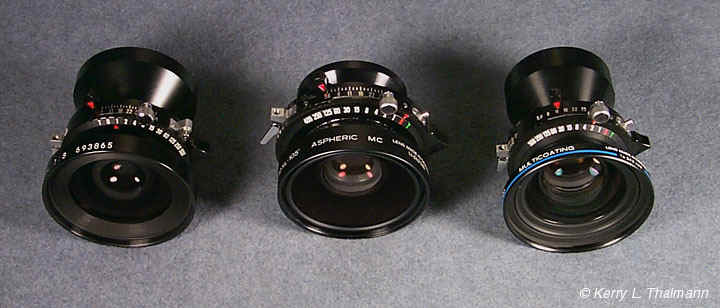
Figure 2. Future Classic 90mm - 120mm Lenses
From Left to Right (weight, filter size, image circle)
90mm f8 Nikon Nikkor SW (355g, 67mm, 235mm)
110mm f5.6 Schneider Super Symmar XL (430g, 67mm, 288mm)
120mm f5.6 Schneider Super Symmar HM (390g, 67mm, 211mm)
90mm f8 Nikkor SW (355g, 67mm, 235mm) - see Figure 2.
The lightest of all modern (Biogon derivative) multi-coated 90mm wide angle lenses. It is
an excellent performer, with great coatings (NIC). It's relatively compact size and
lightweight (lighter than the 90mm Super Angulon at 390g, the 90mm f8 Fujinon SW at 407g and 90mm f6.8 Grandagon-N at 460g) make it a favorite for 4x5 field photography. It also has substantially
greater coverage (235mm) than the other compact (slow) modern 90mm wide angles (216mm for the Super Angulon and Fujinon SW - 221mm
for the Grandagon-N).
110mm f5.6 Schneider Super Symmar XL (430g,
67mm - front, 52mm -rear, 288mm) - see Figure 2.
This is the lens that started this whole discussion. Well, I had to wait seven
months for mine to arrive (of course, they are available off the shelf these days), but it
was well worth the wait. This is one fantastic lens - absolutely amazing sharpness
from corner to corner. The illumination on the ground glass is bright and even.
I instantly found the 110mm focal length to be a very comfortable moderate wide
angle for the way I like to work (I don't use my 90mm nearly as much these days).
This lens is not tiny, but with105 degree coverage, it is a LOT smaller than the 100
degree 120mm f8 Super Angulon (700g, 82mm, 288mm) it is destined to replace - and a full
stop faster as well. As a frame of reference, it's slightly smaller and lighter than
the typical modern 210mm f5.6 plasmat. The rear element is quite tiny, and is
threaded for 52mm filters (a nice touch - especially since I have standardized around this
size filters for my backpacking lenses). The relatively small size and light weight,
combined with huge coverage and mind boggling performance make this lens an instant
classic, and quite simply the most amazing large format optic I have ever used. It
can also serve double duty as a "very wide" for 5x7 use. Now, if only
Schneider would give it a baby brother (it already has a mommy - the 150 SS XL and a BIG
daddy - the 210mm SS XL). An 85mm SS XL would be the ultimate 4x5 wide angle for us
backpackers, or anyone else who favors compact, lightweight lenses with generous coverage
and outstanding sharpness.
120mm f5.6 Schneider Super Symmar HM (390g, 67mm, 211mm) - see Figure 2.
Another lens I feel is destined to be a classic for 4x5 field photographers. It is really
the only modern lens in the desirable 120mm focal length that is best suited for this
application (the 120mm APO Symmar (190g,
49mm, 179mm) is lacking in coverage, the
115mm Grandagon-N (740g, 82mm, 291mm), 120mm Nikkor SW (610g, 77mm, 312mm) and
120mm Super Angulon (700g, 82mm, 288mm -
discontinued, see 110mm Super Symmar XL above) are really 5x7 wide angles and therefore much larger and heavier). It is
not a tiny lens, but it weighs about 1/2 the 115mm Grandagon-N. This one could be shoved
aside by the new 110mm Super Symmar XL (which again is more of a 5x7 wide angle, but small
enough to be favored by 4x5 shooters as well). BTW, personally, I love this lens for
6x17cm and it is currently mounted on my home made 6x17 point and shoot. Note: At the time I originally wrote this, I was not
aware that the 125mm f5.6 Fujinon CM-W (265g, 67mm, 204mm) was available. The
Fujinon is slightly longer in focal length than the Super Symmar HM, nearly
as sharp, with only slightly less coverage. It is a little more
compact, and significantly lighter, and also quite a bit less expensive. Due to the
ever-so-slightly better performance and the extra smidgen of coverage, I still prefer the
120mm Super Symmar XL as a general purpose lens, but the 125mm Fujinon warrants serious
consideration as a backpacking lens, or for those on a more modest budget. Also, now
that the 110mm Super Symmar XL is readily available, used prices on the 120mm Super Symmar
HM seem to have dropped a little. This may make it an exceptional bargain for those
who desire Super Symmar performance, but can get by without the huge coverage of the 110mm
SS XL.
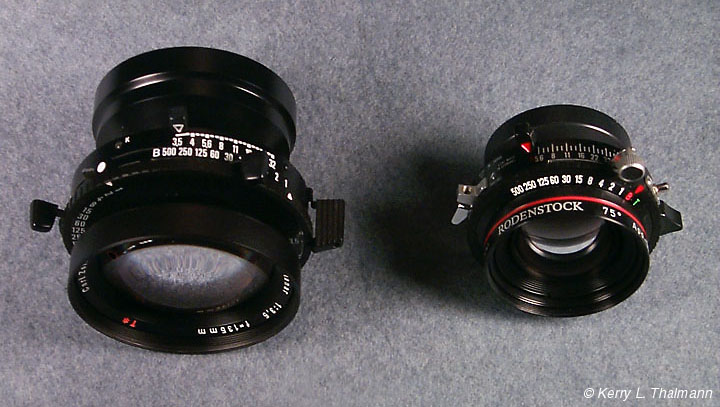
Figure 3. Future Classic 135mm Lenses
From Left to Right (weight, filter size, image circle)
135mm f3.5 Carl Zeiss Planar T* (565g, 67mm, 180mm)
135mm f5.6 Rodenstock APO Sironar-S (215g, 49mm, 208mm)
135mm f3.5 Carl Zeiss
Planar T* (565g, 67mm, 180mm) - see Figure 3.
OK, I admit it, in many respects this lens exhibits the exact
opposite of the characteristics I said I look for in a classic. The coverage (180mm
image circle) is smaller than all the current 135mm plasmats (with image circles in the
195mm - 208mm range). It is also bigger (67mm filters in a Compur #1 shutter) and
heavier (565g) than all the 135mm plasmats. It's basically about the same size and
weight as the typical modern 210mm plasmat. So, why in the heck did it make my list?
Several reasons. First and foremost are rarity and mystique. This is an
extremely rare lens, and is already highly sought after as a collectable (just check the
prices sometime, if you can find one). I'm not sure of the total number of these
produced, but I'm pretty sure it's less than 1000 total units (I've heard anywhere from
150 - 850). That should make it more rare than the Voigtlander APO Lanthars of the
1950s and 1960s, and look what they go for these days. If anything, the 135mm Planar
T* is destined to be even more valuable and sought after. It is the only general
purpose large format taking lens Zeiss ever made featuring their T* multicoating
process. So, in addition to being produced in very limited quantities, it also has
that Zeiss mystique (like a Hasselblad lens for your 4x5 - you too can be a lens snob -
and a format snob to boot). On the practical side (OK, it really isn't a very
practical lens), within it's rather limited coverage, this lens is an outstanding
performer. It is very sharp and contrasty with a pleasing color balance.
Although I tend to try to get everything in sharp focus in my images, I did notice that
this lens seems to transition very smoothly between the in-focus and out-of-focus
areas. Although I'm no expert on the subject, I believe those that are would say
this lens has a very pleasing bokeh. Finally, that f3.5 maximum aperture sure makes
the image nice and bright on the ground glass. The first images I made with this
lens were under heavy overcast in the Olympic rain forest. The exposures were in the
15 - 30 second range. Composing and focusing on the ground glass in such low light
conditions was noticeably easier with this lens than with my f5.6 lenses. So, if
you do find yourself in possession of one of these rare gems, treat it with care lest you
decrease it's value as a collectable, but by all means use it. Mine rides in a well
padded case inside my pack. I keep a filter on it when not using it to provide
additional protection to the front element, and I avoid exposing it to overly harsh
conditions (salt spray, blowing sand, etc.), but I do use it - and enjoy it.
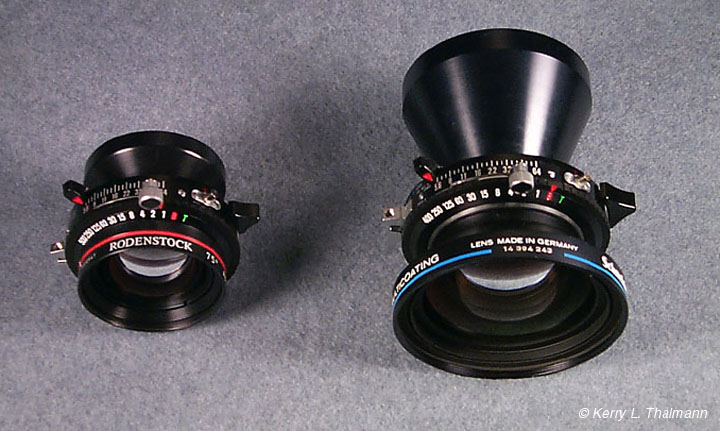
Figure 4. Future Classic 150mm Lenses
From Left to Right (weight, filter size, image circle)
150mm f5.6 Rodenstock APO Sironar-S (230g, 49mm, 231mm) - for 4x5
150mm f5.6 Schneider Super Symmar HM (740g, 77mm, 254mm) - for 5x7
150mm f5.6 Rodenstock APO Sironar-S (230g, 49mm, 231mm) - see Figure 4.
135mm f5.6 Rodenstock APO Sironar-S (215g, 49mm, 208mm) - see
Figure 3.
This is a wonderful little lens. Compact, lightweight and more coverage (231mm) than the
other 150mm 4x5 lenses (I consider the larger 150mm APO Sironar-W and 150mm Super Symmar
HM to be overkill for 4x5 landscapes and better suited for the 5x7 format in that
application - see below). It uses ED glass and is incredibly sharp all the
way to edges, and even at large stops (I have found it to be incredibly sharp even wide
open, and have read at least one test report that showed it to achieve maximum LPM at f5.6
- which is where it should be sharpest in theory, but in practice is rarely true). I don't
know what it is about this lens, but images made with it just scream SHARP! and have an
incredible sense of "depth". I've used a lot 4x5 "normal" lenses, both
modern and classic, and this one beats them all IMHO. Out of all the lenses I own, this is
the last one I would ever part with (you'll have to pry it from my cold, dead hands (OK, 110 SS XL in one hand, 150 APO Sironar-S in the
other)). In general, the comments above also hold true for the
135mm APO Sironar-S (if you prefer that focal length over the slightly longer 150mm).
The 135mm APO Sironar-S has an image circle of 208mm, which is slightly larger than
any of the other current 135s. It also has the wonderful sharpness, compact size and
lightweight of the 150mm APO Sironar-S.
150mm f5.6 Schneider Super Symmar HM (740g, 77mm, 254mm) - see
Figure 4.
Although I vastly prefer the tiny size and light weight of the 150mm APO Sironar-S for
4x5, for 5x7 use the 150mm Super Symmar HM has the benefit of an additional 5 degrees of
covering power. The 80 degree 150mm Super Symmar HM has an image circle of 254mm
(compared to the 231mm image circle of the 75 degree 150mm APO Sironar-S). Although
the APO Sironar-S will cover 5x7 with enough room for very modest movements, for general
purpose use on 5x7, I have found the extra coverage of the 150mm Super Symmar HM to be
quite beneficial (of course, if you are shooting 5x7 and need very generous movements,
there is always the 150mm Super Symmar XL with it's huge 386mm image circle). As I
mentioned above, the availability of the Super Symmar XL series has apparently caused a
decrease in the selling prices for used Super Symmar HM lenses. This may be a
temporary market condition, but right now there are some bargains out there.
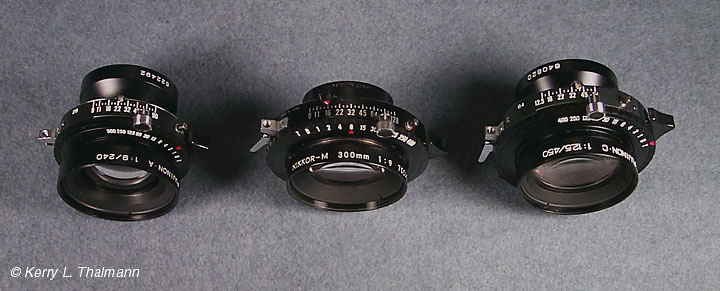
Figure 5. Future Classic 240mm, 300mm and 450mm Lenses
From Left to Right (weight, filter size, image circle)
240mm f9 Fuji Fujinon A (245g, 52mm, 336mm)
300mm f9 Nikon Nikkor M (270g, 52mm, 325mm)
450mm f12.5 Fuji Fujinon C (285g, 52mm, 486mm)
240mm f9 Fujinon A
(245g, 52mm, 336mm) - see Figure 5.
This, my friends, is an absolutely amazing gem of a little lens. It's the longest
non-telephoto focal length ever offered in a #0 shutter, yet it can hit the corners of
8x10 with a little to spare. As an APO process type plasmat, performance, as you
would expect, at close distances is outstanding. I have also used this lens
extensively for distant subjects, and it is also an excellent performer for that
application. Although, it is a stop slower than the 210mm f5.6 plasmats, for hiking
and backpacking, I greatly prefer it due to its compact size, light weight and
smaller filter size. Unfortunately, Fuji decided to discontinue this little beauty
during the summer of 1998. As of this writing, there are still a VERY limited number
of new samples available from existing dealer stock. If you're lucky enough to find
one, I recommend snapping it up. If not, they should be available occasionally on
the used market.
300mm f9 Nikkor M (270g, 52mm, 325mm) - see Figure 5.
Another tiny gem of a lens. Small, sharp, contrasty. What else could you ask for in a long
focal length field lens for 4x5. Variation of the classic Tessar design, but with modern
multi-coatings and a modern Copal shutter. At the time I originally wrote this, the Fujinon lenses were not readily
available in North America. Thanks, in a large part, to Badger Graphic Sales, that is no longer the case.
As an alternative to the 300mm Nikkor M, Fuji offers the 300mm f8.5 Fujinon C
(250g, 52mm, 380mm). It is similar in size and weight to the Nikkor, but with
greater claimed coverage (some people claim the 300mm Nikkor covers quite a bit more than
the published 325mm image circle). I have not used the 300mm Fujinon C, but since it
is of similar design and construction to it's big brother, the 450mm f12.5 Fujinon C - see
below, I suspect it would also be a wonderful performer.
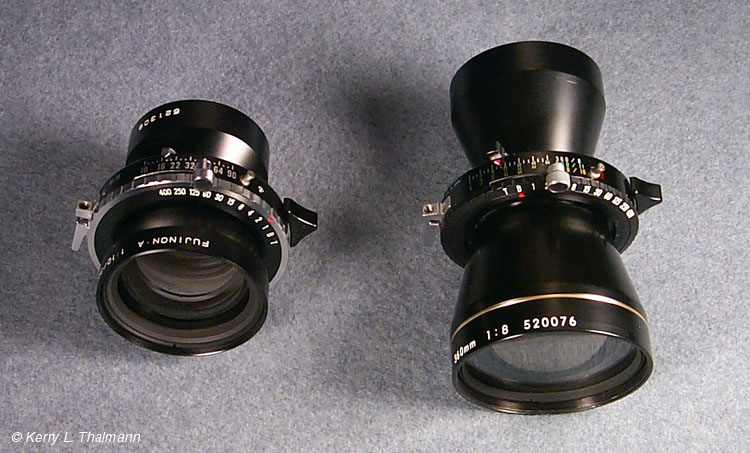
Figure 6. Future Classic 360mm Lenses
From Left to Right (weight, filter size, image circle)
360mm f10 Fuji Fujinon A (475g, 58mm, 504mm)
360mm f8 Nikon Nikkor T-ED (805g, 67mm, 210mm)
360mm f8/500mm f11 Nikkor T-ED (805g, 67mm, 210mm - 185g weight for 500mm rear element) - see Figure 6.
Two great long focal lengths in one and a half lenses. ED glass, true telephoto design.
Extremely sharp for a telephoto (as good or better than most "standard" designs
for distant subjects). 360mm focal length useable with short bellows (~12") field
cameras. 500mm length useable with about 16" of bellows. 720mm option also available
if you want a really long 4x5 lens and have a long bellows monorail or field camera
(Wisner or Canham). This baby is already in hot demand on the used market. Imagine what it
will be like when they haven't been made for 20 or 30 years.
360mm f10 Fujinon A (475g, 58mm front, 52mm rear, 504mm) - see
Figure 6.
I almost didn't include this one. Not because there is anything wrong with it, but
it's a bit of an "in betweener". Although it's quite compact and
lightweight for a lens of this focal length and coverage, it's still considerably bigger
and heavier than the 300mm Nikkor M (or 300mm Fujinon C) and the 450mm Fujinon C.
So, why'd it make the cut? First, it was discontinued in the early 1990s (perhaps
late 1980s) at a time when Fuji lenses had no official North American distributor.
So, by the time Badger Graphic (and others) started unofficially importing Fujinon large
format lenses, there were none available. This makes it much more scarce than the
other compact 300 - 450mm lenses. Also, it is the only 360mm non-telephoto lens ever
offered in a #1 shutter. The other 355/360mm process lenses are all in the huge #3
shutters, and the 360mm Nikkor T-ED, although in a Copal #1 shutter, weighs nearly 70%
more with far less coverage. Also, there are a few lightweight field cameras out
there that have enough bellows extension to use this lens, but not the 450mm Fujinon
C. For the users of those cameras, this is the longest, reasonably compact and
lightweight lens available. Finally, with such huge coverage, this lens will also be
desirable to those shooting with 8x10 (or even 11x14 or 7x17) field cameras. There
aren't many modern, multi-coated lenses this small capable of covering such large formats.
450mm f12.5 Fujinon C (285g, 52mm, 486mm) -
see Figure 5.
Go back and read those numbers again. This lens is an absolutely amazing combination
of long focal length, light weight, compact size and huge coverage. Plus, it's a
great performer as well. This is the longest, by a good margin, non-telephoto ever
offered in a #1 shutter. In terms of compact size and light weight combined
with generous coverage, this lens, more than any other fits my definition of a Future
Classic. Just look at these ratios: focal length/weight = 1.58mm/g; image
circle/weight = 1.71mm/g. When considering lightweight lenses for backpacking, I
discovered there aren't that many lenses with either of these ratios greater than 1.00,
let alone both greater than 1.00 by such wide margins (just for grins, here's the numbers
for a few of the other lightweight, generous coverage lenses that made this list: 150mm
APO Sironar-S - 0.65, 1.00; 240mm Fujinon A - 0.98, 1.37; 300mm Nikkor M - 1.11, 1.20;
360mm Fujinon A - 0.76, 1.06). Of course, with such huge coverage, this lens
is also favored by 8x10, 11x14 and 7x17 shooters. The ONLY thing keeping it from
being even more in demand is that fact that many lightweight 4x5 field cameras have
insufficient bellows extension to use this lens. Too bad, because I can't imagine a
better long lens to pair with a light camera for use in the field.
That's my short list. Since I don't have my 110mm XL yet, I'll leave others to comment on
that one (see above). Also, I did not nominate anything in my favorite
focal length, 210mm. I use a 210mm Nikkor W and love it, but I'm not really sure if it
offers any advantages over the current 210mm offerings from Schneider or Rodenstock.
I am now using a 210mm APO Symmar
and find it to be an excellent performer, but again I see no real reason it should be
considered a Future Classic. I have not used the 210mm APO Sironar-S, but I have no
doubt it would be an excellent performer. It also has a smidge more coverage (316mm)
than the APO Symmar (305mm), Nikkor W (295mm) and Fujinon CM-W (309mm), but this extra
coverage isn't enough to truly set this lens apart from the pack (all of those mentioned
have plenty of coverage for 4x5, or even 5x7, but not enough to be useful on 8x10).
So, many excellent performers in this focal length, but nothing that leaves the others in
the dust (unless you are an 8x10 or 11x14 shooter, then consider the 210mm Super Symmar HM
and the new 210mm Super Symmar XL).
I also didn't nominate any of the ultra wide Super Angulon XL series. I'm amazed by their
tremendous image circles and coverage angles, but as a field photographer specializing in
landscapes the coverage seems overkill and the huge size (and very huge price tag and
huger still filter sizes) are big turn-offs. Perhaps someone who does 4x5 architectural
work will offer a dissenting opinion. I'm sure this is just my personal bias here. I'm just not a big
ultrawide angle user. Still, the 120 degree 47mm Super Angulon XL, the shortest lens
made capable of covering 4x5, meets my basic requirements for consideration as a Future
Classic. Ditto for 72mm Super Angulon XL (although it's a bit large and takes huge
filters) - the shortest lens capable of covering 5x7 (or 4x5 with tons of
movements). Also, I don't shoot roll film (other than an occasional 6x17), but for
those that do, and are fond of really wide lenses, the 35mm APO Grandagon is capable of
covering the 6x12 format (or 6x9/6x7 with generous movements). So, despite my
personal preferences, if I had to chose some ultrawides to be considered for Future
Classic status, these would be the ones.
So, let's hear from everyone else. I'd like to hear from other 4x5 shooters to learn their
favorites and find out what they think of my choices. I'd also like to hear from the 8x10
shooters, and especially the ultra large and banquet shooters. They are the ones who, out
of necessity and practicality, seem to rely most heavily on using classic optics. What do
they think will happen 50 - 100 years down the road when it is even harder to find those
long focal length Dagors? Let me know what you think.
Well, that's my updated list. Who knows if any of these
will actually ever become desirable classics with the mystique and near-cult following of
the Gold Dot Dagors or APO Lanthars. Only time will tell. I don't claim to
have a crystal ball capable of seeing into the future. I've made my comments purely
on a combination of characteristics I consider highly desirable in a large format lens.
The same characteristics that I feel have lead to the desirability of many fine,
older discontinued lenses that are now commanding premium prices on the used market.
With the onslaught of digital photography, the future of sheet film itself is
uncertain. I hope 50 - 100 years from now there will still be a few diehards with
their heads under the darkcloths and their fingers in the hypo. In the meantime,
I'll continue to enjoy using these wonderful optics and appreciate them for what they are
today. I'll let my kids worry about what they'll be worth after I've exposed my last
sheet of film.
© Kerry L. Thalmann, 1997, 1999, 2000